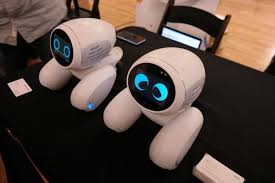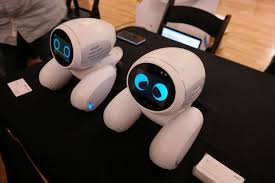
Derived from an affectionate anagram of the phrase "my dog,", Roobo, a Chinese artificial intelligence startup, recently pulled back the curtain on an artificial intelligence-powered "pet robot" named Domgy. Even though his functions are more like robotic housekeeper Rosie than the family's pet dog Astro, Domgy could be yanked from an episode of the classic “Jetsons” cartoon.
Domgy won't require long walks, feedings or bathroom breaks and this differentiates it from other pet dogs that demand human attention and care. This is so because Domgy is the latest is a line of cyber pets that were once heralded as the wave of the future before losing popularity. Sony has shut down a similar project for a robotic dog about a year ago after having manufactured a robot canine.
Roobo is attempting to pick up where Sony left off in some ways. Domgy is more than just a run of the mill automated pet, the company said recently. Weather forecasts, changing of the television channel and even a guard dog are provided to the owners by the "smart-home" features of the robot canine. Identification of strangers and warning owners if an intruder enters the home is made possible by the face recognition capabilities of Domgy.
"With its unique AI capabilities, you can teach Domgy to do different things based on voice commands and visual cues. Unlike a lot of consumer robots on the market, it's both functional and fun," said Anthony Chen, Roobo's marketing director.
He design of Domgy was made in collaboration with the Korean-based Innovative Play Lab, a company Roobo invested in early last year. Roobo has roughly 300 employees since it was founded in 2014 and has offices from Moscow to Seattle. With the goal to make consumer tech more family-friendly, the company continues to explore innovations in robotics, wearables, virtual reality and drones.
"Our ideal consumer target is the family, especially those with busy lives. We are focused on integrating cutting-edge AI and robotic technology to enhance the interactive experience [and] create a smarter, better life," said Chen.
In addition to as several cameras that can be used to take photos and video, useful when Domgy isn't using them to navigate your living room, the nine-inch robotic Domgy is equipped with an emotive, touch-screen face that doubles as a media player.
This is not the first time that Roobo has ventured into the voice-controlled, kid-friendly robot territory. A robot designed to interact with children through educational lessons called "Pudding" was unveiled by the company at CES Las Vegas last year. The bot was a big hit in China.
There are other companies that are also into similar bots. A robot that actually performs limited housework called SpotMini, an all electric robot, was recently debuted by Boston Dynamics.
Fun, companionship and tasks that are less hands on are the major tasks that Roobo's pet is mostly designed for. Domgy can be taught ti dance, speak, play music, and send personal notifications programmed by the user and responds to specific commands.
"Roobo has a big technical team behind its AI, and our AI focus is on improving the family experience. You can combine functions yourself, just like putting together a jigsaw puzzle," such as a choreographed dance routine," said Chen.
(Source:www.cnbc.com)
Domgy won't require long walks, feedings or bathroom breaks and this differentiates it from other pet dogs that demand human attention and care. This is so because Domgy is the latest is a line of cyber pets that were once heralded as the wave of the future before losing popularity. Sony has shut down a similar project for a robotic dog about a year ago after having manufactured a robot canine.
Roobo is attempting to pick up where Sony left off in some ways. Domgy is more than just a run of the mill automated pet, the company said recently. Weather forecasts, changing of the television channel and even a guard dog are provided to the owners by the "smart-home" features of the robot canine. Identification of strangers and warning owners if an intruder enters the home is made possible by the face recognition capabilities of Domgy.
"With its unique AI capabilities, you can teach Domgy to do different things based on voice commands and visual cues. Unlike a lot of consumer robots on the market, it's both functional and fun," said Anthony Chen, Roobo's marketing director.
He design of Domgy was made in collaboration with the Korean-based Innovative Play Lab, a company Roobo invested in early last year. Roobo has roughly 300 employees since it was founded in 2014 and has offices from Moscow to Seattle. With the goal to make consumer tech more family-friendly, the company continues to explore innovations in robotics, wearables, virtual reality and drones.
"Our ideal consumer target is the family, especially those with busy lives. We are focused on integrating cutting-edge AI and robotic technology to enhance the interactive experience [and] create a smarter, better life," said Chen.
In addition to as several cameras that can be used to take photos and video, useful when Domgy isn't using them to navigate your living room, the nine-inch robotic Domgy is equipped with an emotive, touch-screen face that doubles as a media player.
This is not the first time that Roobo has ventured into the voice-controlled, kid-friendly robot territory. A robot designed to interact with children through educational lessons called "Pudding" was unveiled by the company at CES Las Vegas last year. The bot was a big hit in China.
There are other companies that are also into similar bots. A robot that actually performs limited housework called SpotMini, an all electric robot, was recently debuted by Boston Dynamics.
Fun, companionship and tasks that are less hands on are the major tasks that Roobo's pet is mostly designed for. Domgy can be taught ti dance, speak, play music, and send personal notifications programmed by the user and responds to specific commands.
"Roobo has a big technical team behind its AI, and our AI focus is on improving the family experience. You can combine functions yourself, just like putting together a jigsaw puzzle," such as a choreographed dance routine," said Chen.
(Source:www.cnbc.com)














